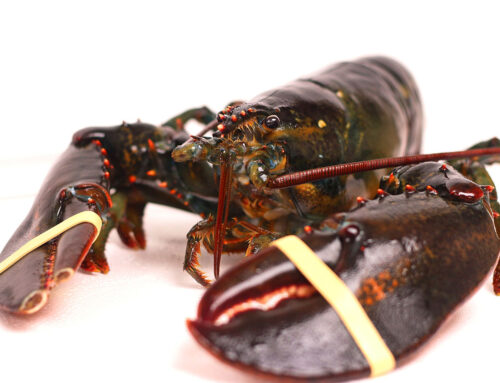Did you ever wonder how that delicious steamed lobster got to your plate?
The cold, clear waters of the Atlantic Ocean provide the biggest and most flavorful lobsters in the world. Rewind to the mid-1600s, when lobsters were casually nabbed inshore using nothing more than a hoop net and a dory. Over time, those methods evolved, giving rise to rounded wooden traps that paved the way for modern, plastic-coated metal frames used by Maine lobstermen today.
Sustainable Harvesting
These modern lobster traps are equipped with escape vents, resembling mail slots, measuring 2 x 6 inches. These vents serve as exits for small marine life and lobsters smaller than the legal catch size of 3 3/8 inches in carapace length, allowing them to swim away and continue growing and reproducing.
This was an ingenious invention by lobstermen themselves — no governmental regulations required! Hence, their foresight “to throw back for the future” and dedication to sea conservation have transformed the Maine lobstering industry into a beacon of sustainability, standing out amidst a sea of depleted resources.
When it’s time to haul in their catch, lobstermen typically use a boat equipped with a winch and a line connected to the buoy, marking each trap’s location. Once they locate the buoy, they carefully pull up the line, bringing the trap to the surface.
Often the sternman’s job is to haul the trap up on deck. After opening the trap, they use a special metal gauge to measure the size of each lobster to ensures that only legal-sized lobsters are kept. Once again, this is a conservation measure invented by lobstermen and hailed as a model for sustainable seafood practices.
Distribution Across the U.S.
Since each lobsterman is a small-scale individual operation, he or she may sell the daily catch to co-ops, which are cooperative organizations formed by fishermen to collectively market and sell their seafood, or the lobsterman may choose to sell directly to seafood wholesalers, local fish markets, restaurants, or through other channels.
If you’re buying Maine lobster from out of state, many reputable suppliers ship lobsters with the utmost care. Typically, shipping containers are Styrofoam with tightly secured lids, ensuring minimal movement during transportation. The best method to keep lobsters at an optimal low temperature is to pack the Styrofoam container with wet packing materials and frozen gel packs. (Pro tip: if you’re ordering lobster for a special delivery date, we recommend that you place your order for delivery at least two to three days before your occasion to ensure an on-time arrival.)
Preparing Lobster
Now that you know how the whole operation works, we’ll get to the best part, how to prepare that delicious lobster. We have provided so many recipes over the years in our blog — here are a couple to get you started:
Delicious lobster is the main event of the Maine Lobster Festival! Plan to attend the Maine Lobster Festival July 31-Aug. 4, 2024! Admission is free again this year! Visit https://mainelobsterfestival.com/ for details.










